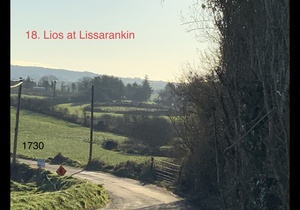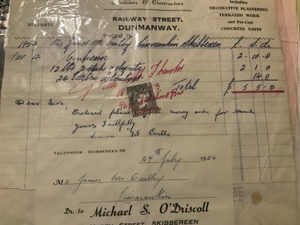Lios an Ruacháin or Lissarankin is a townland of 59 hectares or 145 acres and in the early part of the 20th century, 81 individual fields were mapped in this townland.
It is in the Electoral Division of Castlehaven North, in Civil Parish of Castlehaven and the Roman Catholic Parish of Castlehaven and Myross.
Lios an Ruacháin is bordered by Fearann an Ghiolla (Farranagilla) to the south, Gort na Cloiche (Gortnaclohy) and An Rosach (Russagh) to the west, Leitir an tSinlis (Lettertinlish) to the north and Muine Uí Mhothlacháin (Moneyvollahane) and An Ré (Rea) to the east.
OpenStreetmap contributors, with input from the Castlehaven & Myross History Society, have created a detailed townland map including all its minor placenames. Zoom in for further detail.
Etymology
Lios an Ruacháin can be interpreted as the fort of Rankin. The local pronunciation is Lisarohane. An alternative interpretation which was given by Bruno O'Donoghue is Lios Uí Annracháin or O'Hourihane's fort. The O'Hourihanes were erenaghs of Ross(carbery) - "erenagh" was a medieval office responsible for receiving parish revenue from tithes and rents, building and maintaining church property and overseeing the termonn lands that generated parish income. .
Another account suggests that the name derives from Lios Shrotháin which can be interpreted as the lios of the streamlet or Lios a' Rangain which would mean the lios of the riverbank.
History
We have no history for this townland at present. If you can help, please contact us at [email protected]
Housing
As part of Griffiths Valuation in 1853, a survey of house quality was carried out to calculate what rates were due by each household. These were issued in 1850 in the form of house books and a guide on how to interpret these can be seen here. These show that all three houses in the townland at the time were class 3. This means that they were thatched houses with stone walls with mud or puddle mortar. Within class 3 there are different categories. Two houses are described as being old (more than 25 years) with one being in repair while the other is out of repair. The other thatched house is described as medium (not old), deteriorated by age and not in perfect repair. The class 3 houses are between 6 foot and 6 foot 9 inches tall (indicating that they are probably single-storey at this time)
By the 1901 census, there are now 4 occupied houses in this townland and three have walls of mud, wood or other perishable material while the other one has walls of stone, brick or concrete. Two houses roofs of slate, iron or tiles while the other two are still thatched. Three of the four houses at this time have two, three or four rooms with one having just two windows in front (so probably single storey) while the other two have three and five windows respectively. The other house has five or six rooms with two windows in front (single-storey?).
When we advance to the 1911 census, there is an increase to five occupied houses in this townland and all five now have walls of stone, brick or concrete with roofs of slate, iron or tiles while the other is still thatched. Fourof the five houses at this time have two, three or four rooms with two having just two windows in front (so probably single storey) while the other two have five windows in front. The other house has five or six rooms with five windows in front.
Places of Interest
Lios: There is a ringfort (lios) in this townland. A ringfort is a circular fortified settlement that were mainly built during the Bronze age up to about the year 1000. This is the best-preserved lios in the parish and possibly the largest.
The Historic Environment Viewer lists the ringfort mentioned above
Interesting Placenames
No field names or any other placenames have been recorded for this townland. If you are aware of any, please contact us at please contact us at [email protected]
Folklore
We have no folklore for this townland at present. If you can help, please contact us at [email protected]
Families and Notable Residents
The Tithe Applotment books of 1825 list the following family names: Bradfield, Bradfield, Peters (?), Sullivan, Sullivan, Sullivan
Griffiths Valuation of 1853 lists the following family names: Sullivan, Sullivan, Sullivan
The Census of Ireland of 1901 lists the following family names: Sullivan, Sullivan, Sullivan, Sullivan
The Census of Ireland of 1911 lists the following family names: Hurley, Sullivan, Carey, Sullivan, Sullivan, Sullivan
Note: the term 'with' refers to a person or persons of a different family name staying in the house. This may have been an in-law or other relative, a guest, or a farm labourer/housekeeper or domestic servant.
Demographics and Landholding
| *Occupiers | Population | Change | Link to record | ||
| 1825 | Tithe Applotment | 6 | 42 (est) | 1825 | |
| 1841 | Census of Ireland | 8 | 49 | ||
| 1851 | Census of Ireland | 3 | 28 | ||
| 1853 | Griffith's Valuation |
3 |
28 (est) | 1853 | |
| 1861 | Census of Ireland | 5 | 36 | ||
| 1871 | Census of Ireland | 6 | 38 | ||
| 1881 | Census of Ireland | 5 | 57 | ||
| 1891 | Census of Ireland | 5 | 49 | ||
| 1901 | Census of Ireland | 5 (Incl. 1 unoccupied) | 29 | 1901 | |
| 1911 | Census of Ireland | 6 | 26 | 1911 |
*Occupiers generally equate to households having a house and land but may also include households having houses but no land.
Between 1656 and 1658 the Down Survey mapped all areas of the country to track ownership of land after much had been granted to followers of Cromwell after the war of the 1650's. The most prominent proprietor (titulado) of this townland at that time was Charles McCarthy Reagh who was described as an Irish papist. This townland was part of Rathnapoole, Monymohalahan & Lisranckan at that time.
The proprietor of this townland in 1841 was Colonel John Townsend of Castletownshend and his agent was Charles Clerke of Skibbereen. It was all held under lease by A. Attridge of Oldcourt, sub-let by lease to Thomas Leader of Cork and held by tenants without a lease.
In 1841, the soil was described as middling, producing light crops of wheat, oats and potatoes.
Images
Further Reading
-
Placenames Database of Ireland Logainm.ie entry for statutory version in Irish and English
- A Collection Of Placenames From Cork County, Barony Of West Carbery (East Div.),Volume 2 - Dr Éamon Lankford
- Castlehaven & Myross History Society Journal Vol. 1 - 2020
- Castlehaven & Myross History Society Journal Vol. 2 - 2021
- Castlehaven & Myross History Society Journal Vol. 3 - 2022
- Parish Histories and Place Names of West Cork - Bruno O'Donoghue
- See townlands.ie for information on this townland
Links
Go to Homepage
Go to list of Townlands
Go to list of Irish words used locally
Go to local Flora and Fauna




